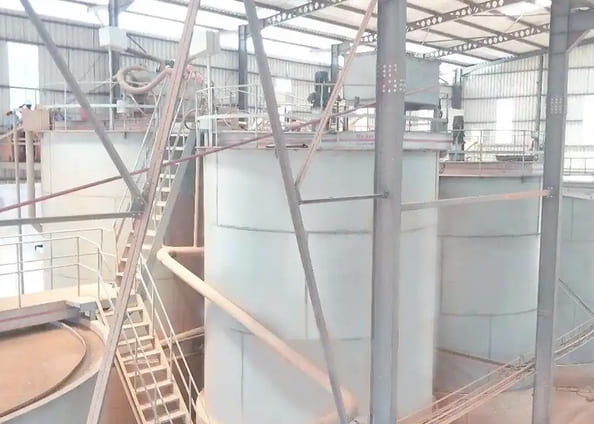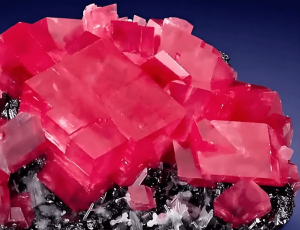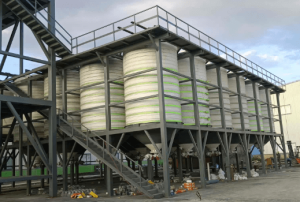The method of extracting gold from gold-bearing ores is determined by the type and properties of the ore. Generally, ores can be divided into two categories based on their suitability for cyanide leaching: easily leached gold ores and refractory gold ores. This article outlines the definition, causes, and beneficiation process of refractory gold ores.
What Are Refractory Gold Ores?
Some gold ores resist easy extraction. These stubborn ores frustrate miners and reduce profits. Refractory gold ores contain gold locked inside sulfide minerals or carbonaceous materials.
Refractory gold ores are gold-bearing materials that resist standard cyanidation due to their chemical composition or physical structure. Gold remains trapped inside mineral grains or reacts with carbon, requiring advanced pretreatment methods.
Traditional extraction fails with these ores. Miners face lower recovery rates and higher costs. Yet, refractory ores contain significant gold deposits worth extracting.

Why Gold Ores Are Refractory?
Not all gold ores surrender their treasure easily. Refractory ores hide gold behind chemical barriers.
Gold becomes refractory when trapped inside sulfide minerals (like pyrite or arsenopyrite) or absorbed by carbonaceous materials. These prevent cyanide solutions from accessing and dissolving the gold particles.
Sulfides shield gold from leaching. Carbon steals dissolved gold from solutions. Both scenarios demand extra processing steps.
Five Main Causes of Refractory Behavior
1. Physical Encapsulation
Gold in the ore is present in fine or submicronized particles, encapsulated or impregnated within sulfide minerals (such as pyrite, arsenopyrite, and pyrrhotite) or silicate minerals (such as quartz), or within the lattice structure of sulfide minerals. This encapsulated gold is difficult to dissociate, even with fine grinding, making it incompatible with cyanide.
2. Side Effects of Oxygen- and Cyanide-Consuming Minerals
Metal sulfides and oxides, such as those of arsenic, copper, antimony, iron, manganese, lead, zinc, nickel, and cobalt, are often present in ores. These metal sulfides and oxides exhibit high solubility in alkaline chloride solutions, consuming significant amounts of cyanide and dissolved oxygen in the solution, and forming various cyanide complexes and SCN-ions, thereby interfering with gold oxidation and leaching. The most important oxygen-consuming minerals in ores are pyrrhotite, marcasite, and arsenopyrite; the most important cyanide-consuming minerals are arsenopyrite, chalcopyrite, bornite, stibnite, and galena.
3. Passivation of the Gold Particle Surface
During the ore oxidation process, the gold particle surface comes into contact with the cyanide slurry. Sulfide films, peroxide films (such as calcium peroxide films), oxide films, and insoluble cyanide films may form on the gold particle surface, passivating the gold surface and significantly reducing the oxidation and leaching rates of the gold particles. The presence of sulfides in gold ore affects gold dissolution in various ways. One explanation is that the dissolution of sulfides produces soluble sulfides (S₂- or HS₂-), which react with gold to form a sulfide film, passivating the gold particle surface. Another theory suggests that the sulfide surface forms a dynamic reduction couple, which oxidizes the gold particles to form a dense cyanide-containing complex film, thus passivating the gold.
4. “Gold-Robbing” Effect of Carbonaceous Materials
Ore often contains carbonaceous materials (such as activated carbon, graphite, humic acid) and clay, along with other minerals that readily adsorb gold. During the cyanide leaching process, these minerals can preemptively adsorb gold-cyanide complexes, a phenomenon known as the “gold robbing” effect. This results in gold loss in the cyanide tailings, severely impacting gold recovery.
5. Presence of Insoluble Gold Compounds
In some ores, gold exists as tellurides (such as tellurium-gold, tellurium-silver-gold, tellurium-antimony-gold, tellurium-copper-gold), solid-solution silver-gold, and other alloys. These react very slowly in cyanide solutions. Furthermore, harzburgite, bismuth-gold, and gold complexes with humic acid are also difficult to dissolve in cyanide solutions.
What Is the Process for Refractory Gold Ore?
Standard cyanidation fails here. Refractory ores need careful unlocking before extraction.
Processing refractory gold involves three key stages: ore preparation, pretreatment, then conventional cyanidation. The pretreatment step breaks mineral barriers to expose gold for leaching.
Traditional methods won’t work here. We must first alter the ore’s structure to liberate gold.
Detailed Processing Sequence
Here’s how refractory ores get transformed:
Step | Purpose | Methods |
Crushing/grinding | Increase surface area | |
Pretreatment | Liberate gold | Roasting, pressure oxidation |
Cyanidation | Extract gold | Tank leaching, CIP |
Recovery | Collect gold | Electrowinning, carbon stripping |
Pretreatment remains the critical phase. Without it, gold recovery stays disappointingly low.

What Are the Methods for Pretreatment of Refractory Gold Ore?
Standard extraction fails, but smart pretreatment succeeds. Miners have proven tools to attack refractory ores.
Key pretreatment methods include roasting, pressure oxidation, bio-oxidation, and ultrafine grinding. Each breaks sulfide matrices or neutralizes carbon to expose gold for cyanidation.
Different ores require different approaches. The best method depends on mineralogy and economics.
1. Roasting
Roasting is a method that decomposes sulfide minerals containing gold into porous oxides through high-temperature gas injection, thereby exposing the gold within. This method is highly adaptable, simple to operate, and technically mature. Roasting sulfides at 650-750°C can achieve gold leaching rates exceeding 77%.
Key chemical reactions during roasting include:
Pyrite oxidation: 3FeS₂ + 8O₂ → Fe₃O₄ + 6SO₂↑
Arsenopyrite oxidation: 12FeAsS + 29O₂ → 4Fe₃O₄ + 6As₂O₃↑ + 12SO₂
2. Pressure Oxidation
Wet pressure oxidation is a method for treating ore pulp at pressures of 0.5-1.8 MPa and temperatures of 70-150°C. Its application at the Porgera gold mine resulted in a leaching rate of 97%, but the equipment costs are relatively high.
This method accelerates sulfide oxidation under high pressure and high temperature, effectively treating high-arsenic and high-sulfur, difficult-to-leach gold ores. However, it requires specialized equipment such as an acid-resistant autoclave.
3. Bio-oxidation
Biooxidation is a method that utilizes microorganisms such as iron-sulfur bacteria to oxidize and decompose sulfides. By adsorbing onto the ore surface, these microorganisms metabolically oxidize sulfides into sulfates and arsenides into arsenates.
This method offers advantages such as environmental friendliness and high selectivity, producing no dust or harmful gases, with relatively low infrastructure investment. However, it suffers from drawbacks including a lengthy oxidation cycle (approximately 6 days), low pulp concentration (18-20%), and high energy consumption.
4. Ultrafine Grinding
Ultrafine grinding is a physical pretreatment method that increases the exposure area of gold particles by grinding ore to a finer particle size (typically reaching the micron level), thereby enhancing cyanide leaching efficiency. This method primarily utilizes the collision and friction forces generated by grinding media (such as steel balls or ceramic balls) during high-speed rotation to achieve material pulverization.
Comparing Pretreatment Options
Pretreatment Methods | Intro. | Pros | Cons |
Roasting | Burns sulfides at high temperatures. Creates a porous oxide structure. | Proven technology | Arsenic emissions |
Pressure Oxidation | Uses heat, pressure, and oxygen. Oxidizes sulfides in autoclaves. | High gold recovery | High capital costs |
Bio-oxidation | Bacteria eat sulfide minerals. Environmentally friendly. | Lower operating costs | Slower process |
Ultrafine Grinding | Pulverizes ore particles. Physically exposes gold. | Simple concept | High energy use |
Each mine must evaluate which method fits its specific ore characteristics.
Conclusion
Refractory gold ores challenge miners but contain valuable deposits. These ores resist standard cyanidation due to sulfide encapsulation or carbon interference. Successful processing requires tailored pretreatment, like roasting or pressure oxidation, to liberate gold. Understanding your ore’s specific refractory characteristics determines the most effective extraction method. With proper pretreatment, even stubborn ores can yield their golden rewards.



